Welcome to the first blog of Club Z In-Home and Online Tutoring of North Tampa, South Tampa, and North Pinellas.
There are two impending deadlines facing parents of Hillsborough and Pinellas County public-school students: the submission of a learning option choice for their child/children:
Hillsborough County – parental choice deadline is Sunday July 19 at midnight
Pinellas County – parental choice deadline is Monday, July 27 by 5pm
Pasco County – parental choice deadline was Wednesday July 8th
Before discussing the two highest priorities for parents regarding the reopening of schools in Tampa Bay, here are four images of traditional classrooms outside the United States as they have adapted to social distancing and safety measures:
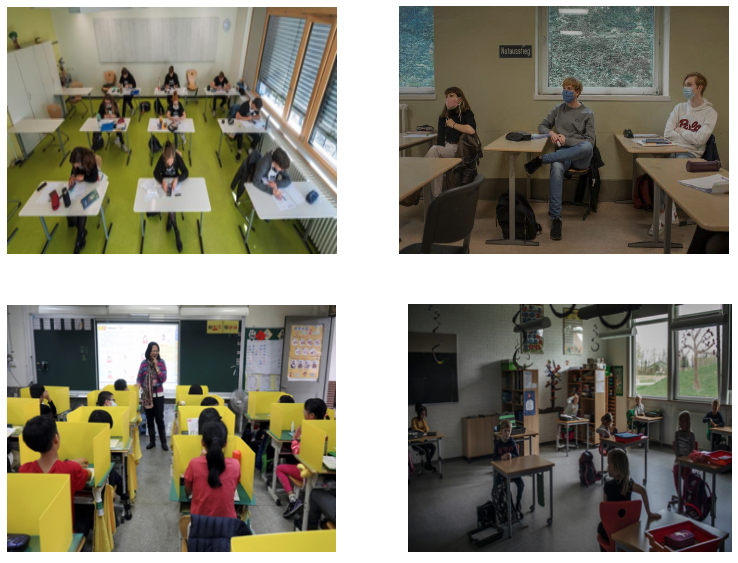
The reopening of Greater Tampa Bay schools in mid-August is uppermost in the mind of every parent. Although the reopening of public schools has now become a national political football in the midst of a pandemic during this Presidential election year, the political rhetoric does not address parents’ two immediate concerns:
Will my children receive a good public-school education in the midst of this pandemic? Which learning option should I select?
Should I send my child back into the traditional public-school classroom? Will the schools be safe?
On July 12th, the reported daily total of new coronavirus infections within Florida was 15,300. To put this in perspective, Florida ranked 4th globally in the number of new infections after the United States, Brazil, and India on that particular day. At this time, “evidence-based reasoning” (a science mantra taught in our region’s science classes as early as 3rd grade) would conclude that, as infection rate spikes in Florida — death rates will spike as well. Tampa Bay is not Miami as far as COVID-19 epicenters are concerned, but increasing infection rates will undoubtedly affect how schools re-open. We suggest that public school parents take this into consideration as they select the learning option for their children.
Reopening plans for the Hillsborough, Pasco and Pinellas School Districts are predicated on three different phases of coronavirus spread. These phases were outlined in the Plan for Florida’s Recovery, which was created by the Re-Open Florida Task Force and submitted to Governor DeSantis on April 29th. (Pinellas Public Schools Superintendent Dr. Michael Grego served on the Task Force.) The subtitle of the report was: Safe. Smart. Step-by-Step.
If you would like to refresh your memory about Recovery Phases 1, 2, and 3, here is a link to the full report: https://www.flgov.com/wp-content/uploads/covid19/Taskforce%20Report.pdf
If you are pressed for time (who isn’t?), here is a link to the Cliff Notes version of the report: https://www.flgov.com/wp-content/uploads/covid19/Safe%20Smart%20Step_Templat4.29%20FINAL.pdf
The State of Florida entered Phase 2 of reopening on June 5th. The Task Force report states that “Phase 3 will begin after the successful conclusion of Phase 2… This will occur when there is no evidence of a rebound or resurgence of COVID-19 cases.”
Of the three school district reopening plans, Hillsborough County’s plan was the most explicit as to how an increasing coronavirus spread may impact the district’s reopening of brick and mortar schools:
Phase 3 = Low Spread » Brick and Mortar schools will open at 50-100% student capacity
Phase 2 = Moderate Spread » Brick and Mortar schools will open up to 50% student capacity
Phase 1 = Substantial Spread »Brick and Mortar schools will shut down at 0-25% student capacity
Phase 0 = full shutdown of schools on March 16, 2020
The $64,000 question is this: within the next month, will Florida move on to Phase 3 of recovery, or possibly revert back to Phase 1? Given this uncertainty, all public and private school reopening planning no doubt necessitated a “hope for the best, but plan for the worst” approach. And, given the sheer number of students who attend Hillsborough, Pasco, and Pinellas Counties public schools, planning for the 2020-21 academic year is an historic challenge.
We assume that the following learning options were created with a Phase 3 of recovery. All learning option descriptions are extracted from reopening plans e-mailed to parents and/or posted on each school district’s website.
On August 24, students will report to their assigned school full-time and return to traditional face-to-face instruction five days weekly with increased health and safety measure in place.
On August 24, students will report to their campuses and classrooms with a traditional school schedule and in-person instruction. Enhanced health and safety precautions will be in place.
On August 24, students report to their assigned school and keep their seat within their District Application program. Traditional face-to-face instruction five days weekly with PCS protocols for health and safety in place.
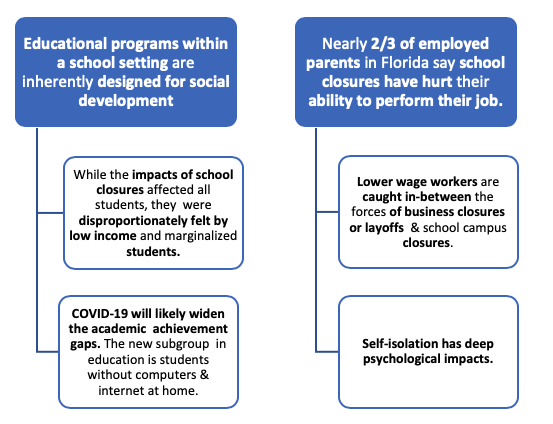
On August 24, students, from their homes, will participate in full-time eLearning that originates from their regular school.
Pasco County — “mySchool Online”
On August 24, students, from their homes, will participate in full-time mySchool Online that originates from their regular school.
On August 24, students, from their homes, will participate in full-time MyPCS Online that originates from their regular school.
The Pinellas district reopening plan provided a sample elementary level daily schedule:
8:45-9:00 Morning Meeting
9:00- 9:20 Direct Face-to-Face Instruction Reading (live)
9:20-10:20 Independent Practice and live small group instruction
10:20-10:55 Direct Instruction Writing and Independent Practice (live)
10:55-11:25 Reading Intervention (live)
11:25-11:45 Recess
11:45-12:15 Lunch
12:15-12:35 Direct Math Instruction (live)
12:35-1:05 Independent Math Practice
1:05-1:25 Math Intervention, small group and independent
1:25-2:15 Specials (Art, Music, P.E recorded lessons with some live interaction) 2:15-2:55 Science Direct Instruction (live)
All three public school districts have presented parents with a third option — a county specific version of Florida Virtual School (aka FLVS).
Hillsborough County — “Option C” – Hillsborough Virtual School
Pasco County — “Pasco eSchool”
Pinellas County — “Pinellas Virtual School”
These virtual school programs are independent, fully accredited, and flexible options for public school and some private schools. The major features of these virtual schools are:
Hillsborough Virtual School, Pasco eSchool, and Pinellas Virtual School will be completely unaffected by any phase of statewide recovery and school reopening. By its very nature, virtual school practiced social distancing well before the phrase became a part of our “new normal”.
The same applies to the districts’ eLearning, myPasco Online, and MyPCS Online platforms. They will be largely unaffected by a pivot to Phase 2 planning protocols.
However, if the coronavirus continues to spike in the weeks and months ahead, concern for student/teacher/staff safety may leave the public health officials and school district superintendents with the need to mitigate the spread by reducing the number of students who can attend brick-and-mortar schools on a given day. This is one of the reasons why obtaining final numbers for traditional school students this August is so critical for planning a hybrid model.
Consider these proposed classroom seating charts provided in the Pinellas County School reopening plans:
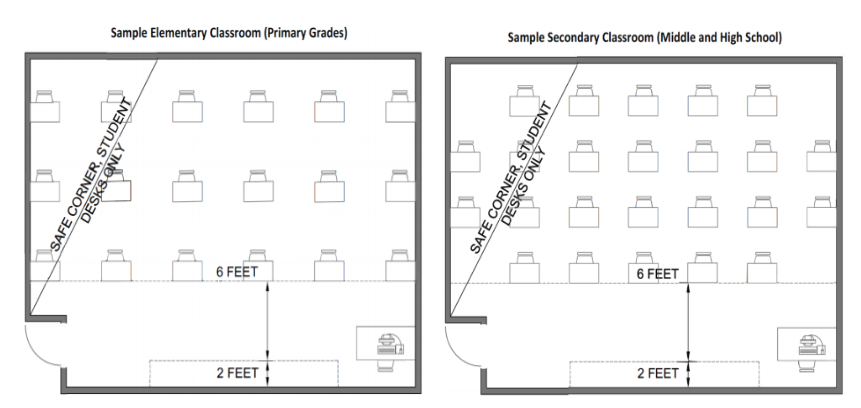
These depict 18 desks in a typical elementary classroom and 24 desks in a typical middle school or high school classroom. There will be further discussion about school safety in the next section of this blog, but the challenge facing the school districts is – will such classroom configurations be safe in the event of a coronavirus moderate spread or substantial spread. This dilemma has created the need for a “hybrid model”.
For planning persons, Hillsborough County’s Phase 2 hybrid model pivots to a blended schedule whereby 40-50% of the student body (Group A) will receive face-to-face instruction in school for 4 consecutive school days while the remaining 50-60% (Group B) will log in to their computers at home for 6 consecutive days of eLearning. Yes, we also thought what you are thinking: this is a logistical nightmare to administrate.
Here is a link to the July 3rd You Tube posting (4 minutes in length) by HCPS Superintendent Addison Davis in which he explains the hybrid model and the HCPS reopening plan:
Pasco County’s contingency plan would have traditional classroom instruction pivot to “50% of direct instruction coming through activities in a virtual environment.” In other words, there will likely be migration of some form to mySchool Online.
Here is a link to the July 9th video posting (2.5 minutes in length) by PCPS Superintendent Kurt Browning in which he provides a reopening update and verbally states that nearly 70% of parents who responded chose the traditional school option:
As reported by the Tampa Bay Times on July 14th, 80% of Pasco County public school parents responded by the July 8th deadline with these tallies:
46% — preferred traditional classroom only
34% — would accept either traditional classroom or online classes
20% — remote instruction only
In a Pasco County School Board meeting on July 15th, Superintendent Michael Grego “made it clear that, if the coronavirus continues to spread unchecked, the district might not be able to open its [brick-and-mortar] schools on August 12,” as reported by the Tampa Bay Times.
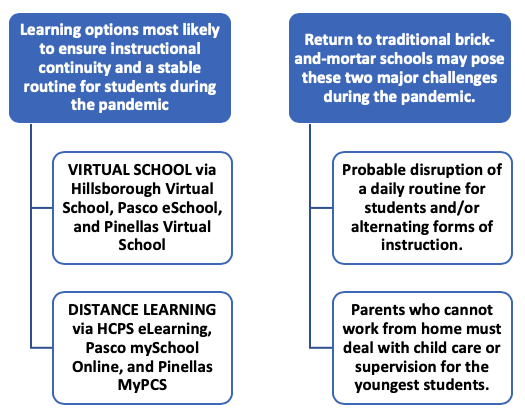
For those parents considering either of the virtual options: based on our experience tutoring students one-on-one in both categories, here follows Club Z’s perspective:
Virtual schooling in our region is led by Florida Virtual School; founded in 1997, its curriculum and processes are time-tested and solid. That said, FLVS (or the three variations of offered by the school districts) is not recommended for students who are generally poor students, lack motivation, or lack any self-discipline. (These students generally require hands-on supervision and instruction by a tutor.) Our FLVS students have tended to be:
FLVS instructors primarily monitor students’ timely completion of assignments, grade non-multiple-choice tests or exams, and chat with students by phone at the end of every learning module (chapter). There is no face-to-face contact between virtual schoolteachers and their students.
Distance learning programs were implemented on very short notice during the 4th quarter this past Spring. It serves no purpose to rehash the fact that both teachers and parents were disappointed with the lack of structure, lack of content in many cases, and the amount of time required by parents to oversee their children’s distance learning. Parents also expressed concern that their children retained little of whatever content was covered. To be fair, most of the teachers did the best they could do in an emergency situation. As Pasco Schools Superintendent Browning recently stated: “The live online model [for reopening] should be more like what families wanted in the spring, offering more structure and regular interaction with teachers. Those were among the lessons learned from the final quarter.”
Club Z tutors observed a broad spectrum of distance learning programs, both private and public schools. For sure, most of the expensive private schools were worth every penny during the shutdown; the pivot from in-school instruction to virtual instruction was seamless in most cases. The students at these schools spent as much time on homework virtually as they had spent on homework pre-shutdown.
Our observations of what occurred vis-à-vis public and charter school instruction was a different matter. We’ll share just a few:
No doubt, the distance learning programs for all three districts have been overhauled during the summer. As Pasco Schools Superintendent Browning recently stated: “The live online model [for reopening] should be more like what families wanted in the spring, offering more structure and regular interaction with teachers. Those were among the lessons learned from the final quarter [during the shutdown].”
One final reminder: the deadlines for Hillsborough and Pinellas public school parents to submit their preference for the learning options are:
•Hillsborough County Parental Choice Deadline is: Friday, July 17 •by midnight
•Pinellas County Parental Choice Deadline is: •Monday, July 27 •by 5:00pm
•Pasco County Parental Choice Deadline WAS: •July 8
It is critical for the Hillsborough, Pasco and Pinellas Counties School Districts to obtain final tallies of parents’ preferences (traditional classroom versus either virtual learning option) in order to determine the total number of students physically returning to the schools versus the total number of students opting for virtual classrooms. Those numbers will determine 1) the number of additional teachers and/or support staff who may need to be hired, and 2) the configuration of classrooms and distribution of students per classroom. This leads us to the second major concern of all parents regarding school reopening.
We opened the blog with this statistic: On July 12th, the reported daily total of new coronavirus infections within Florida was 15,300. To put this in perspective, on this particular day, Florida ranked 4th globally in the number of new infections after the United States, Brazil, and India.
You have likely heard comments like these of late:
Frankly, until effective vaccines are developed and successfully distributed, there will be no “back-to-normal” as we lived and worked prior to the pandemic. The labs and researchers seeking to develop an effective and safe vaccine at an unprecedented pace are racing against the proverbial clock. It is understandable that vaccine development could not possibly meet an arbitrary deadline of mid-August, 2020.
Therefore, our suggestion to parents is to listen to the evidence presented by the medical experts and heed their recommendations. Certainly, school Superintendents Davis (Hillsborough Co.), Browning (Pasco County), and Grego (Pinellas County) have created their school re-opening plans in close coordination with their county Public Health commissioners. They have mandated that all students wear masks.
What role can parents play in the enforcement of wearing masks in the school? We were particularly struck by this statement from Hillsborough County Public Schools Superintendent Addison Davis:
“We urge our families to practice
with their children at home
to get them used to wearing a cloth mask.”
Club Z suggests that parents go a step further and also explain to their children WHY it is important to wear masks in any public spaces outside the home. The more children learn the facts, the more they will understand why wearing masks is important. Here are a few suggestions:
One of our Club Z parents shared that wearing masks all day at school would be “inconvenient’ for younger people. Our response was pointed:
Inconvenience is relative, and a smattering of history and current events can help us all maintain perspective. It was inconvenient to be a Jewish 12-year old in a European concentration camp during WWII. It was inconvenient for a 10-year old to work as a child laborer in the United States from the Industrial Revolution through the 1930s. It was even more inconvenient to be born a slave in the United States. Currently, it is inconvenient to be a Syrian 6-year old in a refugee camp because his or her town was bombed to smithereens. It is inconvenient to be a 7-year old detainee in an ICE facility near the Mexican border, separated from your parents. If wearing masks is the most inconvenient thing schoolchildren will experience right now, they should thank their lucky stars.
Children and teens are resilient. They will accept the need to wear face masks in stride provided that 1) they understand how the wearing of face masks can help control the spread of the coronavirus throughout the U.S., and 2) their parents set the example of wearing face masks in public.
One private school in South Tampa has allowed their youngest students to wear face shields instead of face masks. In true entrepreneurial spirit, there are is enterprising company already marketing its products on Amazon:
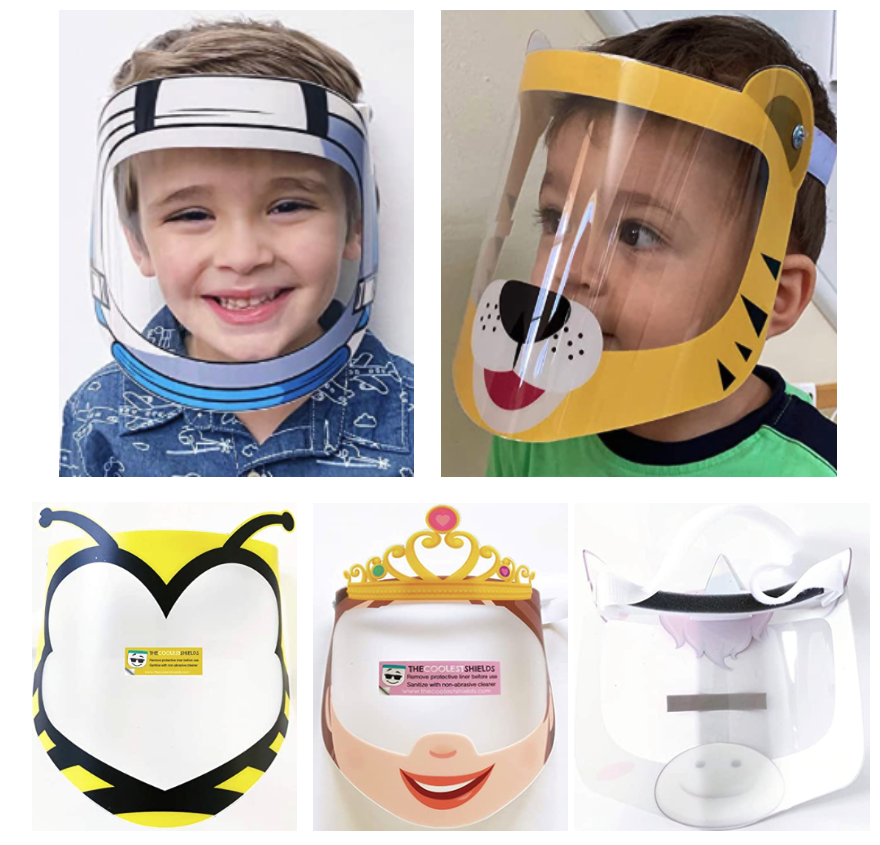
In this screenshot of a Zoom meeting, Leon County Schools Asst. Superintendent Alan Cox displays a face mask embedded with a clear plastic panel. Mr. Cox says it will aid students who rely on lip-reading or facial expressions in his district:
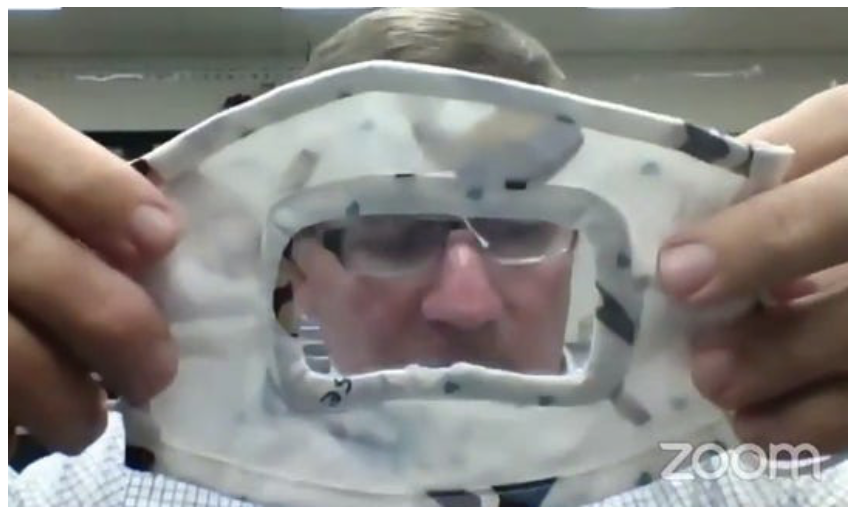 20) Additional School Safety Protocols for Reopening
20) Additional School Safety Protocols for Reopening
There are other safety protocols outlined in the district reopening plans, including
The Number One safety measure within brick-and-mortar schools will undoubtedly be the wearing of face masks (or face shields for the youngest students).
In the days ahead, we will learn more from the school districts regarding how many students will be returning to each school for in-person instruction school. That in turn will generate more specific information regarding classroom configuration, cafeteria configuration and management, and how hallway traffic and social distancing will be managed. As the three school districts mastermind the massive jigsaw puzzle of reopening the schools in the midst of Florida’s current coronavirus spike, let’s support the mandate for students to wear masks in school buildings. Above all, select the reopening learning option for your child and your family after careful consideration.
“I’m not sure what my child is supposed to be learning.”
For the parents of primary school age children, here are some insights regarding The 3 Most Important Skills to Learn in Grades K-3.